

'You have to go to the roof': This man shovelled radioactive debris on top of Chernobyl reactor. Updated about 2 hours agoFri 21 Jun 2019, 11:42pm "Sometimes it happens in life that someone, somewhere, has to do something.

Whether they want to or not. " Key points: At age 32, Jaan Krinal was forced to go to Chernobyl and clean the roof of the reactorHe says men were initially enthusiastic to help eliminate the radiationOne-third of the men of his town he served with in Chernobyl have died When he left his wife and two children on May 7, 1986 and went to work, Jaan Krinal didn't know he would be one of those people. Perceived as affluent, Jewish Australians in poverty 'try their best to hide it' Posted 41 minutes agoSun 23 Jun 2019, 12:00am How do you remove the stigma of poverty in a community that's perceived — not always correctly — as affluent?
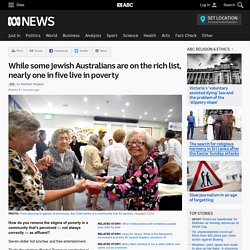
Seven-dollar hot lunches and free entertainment. She joined the not-for-profit as chief executive eight months ago, and now oversees a raft of services delivered to Jewish seniors and those with a disability. There's debt counselling and shopping assistance, phone calls for lonely individuals and Kosher Meals on Wheels. 9th Making Cities Liveable Conference, Melbourne 2016. Liveable Cities Blog - Healthy Cities.
UN-HABITAT. Half of humanity now lives in cities, and within two decades, nearly 60 per cent of the world’s people will be urban dwellers.
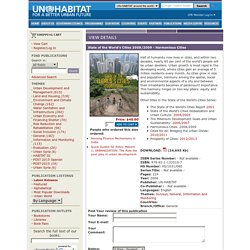
Urban growth is most rapid in the developing world, where cities gain an average of 5 million residents every month. As cities grow in size and population, harmony among the spatial, social and environmental aspects of a city and between their inhabitants becomes of paramount importance. Untitled. Practical tools for creating sustainable cities and communities. Megacities and climate change – A brief overview. Open Access Abstract Cities have developed into the hotspots of human economic activity.
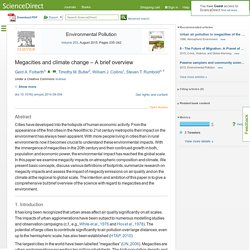
From the appearance of the first cities in the Neolithic to 21st century metropolis their impact on the environment has always been apparent. With more people living in cities than in rural environments now it becomes crucial to understand these environmental impacts. With the immergence of megacities in the 20th century and their continued growth in both, population and economic power, the environmental impact has reached the global scale. 1. It has long been recognized that urban areas affect air quality significantly on all scales.
Community Indicators Victoria. HSH724 - Glocal Action for Healthy Cities and Communities. By 2050, the Greenest City May Not Be in the First World. Chapter 2. Other Models for Promoting Community Health and Development. What is Healthy Cities/Healthy Communities?
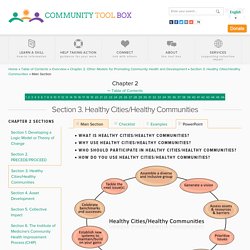
Why use Healthy Cities/Healthy Communities? Who should participate in Healthy Cities/Healthy Communities? How do you use Healthy Cities/Healthy Communities? In this video, Tyler Norris, Vice President of Kaiser Permanente Center for Total Health, discusses the meaning and impacts of community health. "What is a healthy community? Do Healthy Cities Work? A Logic of Method for Assessing Impact and Outcome of Healthy Cities.
Flood-damaged-pastures-decision-treefinal.pdf. The Growing Green Guide for Melbourne project is investigating the potential to transform Melbourne’s roofs, walls and facades into vegetated, leafy habitats. Brent Toderian sur Twitter : "5 things you learn about the connection between happiness & urban design from @thehappycity: International Conference: Towards Building Sustainable Learning Cities. Nightingale. Council House 2 – Our green building. DIVERCITIES - Governing Urban Diversity. Cities With the Worst Urban Planning: Jakarta, Dubai, and Dhaka Top Our List.
Jaime Lerner: A song of the city. Projects. ‘Nobody Is Truly Ready' For Rise Of Seas. This story originally appeared on Climate Central.
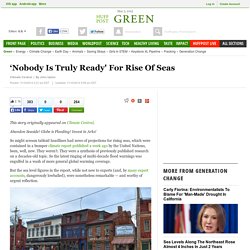
Abandon Seaside! Globe is Flooding! Invest in Arks! So might scream tabloid headlines had news of projections for rising seas, which were contained in a bumper climate report published a week ago by the United Nations, been, well, new. Theconversation. It’s not been a good year so far for major transport projects in Australia’s capital cities.
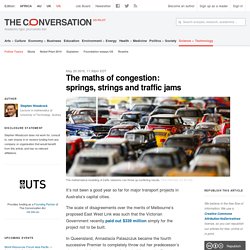
The scale of disagreements over the merits of Melbourne’s proposed East West Link was such that the Victorian Government recently paid out $339 million simply for the project not to be built. In Queensland, Annastacia Palaszczuk became the fourth successive Premier to completely throw out her predecessor’s signature infrastructure project – in this case the Bus and Train (BaT) Tunnel. While Sydney’s WestConnex project is still going ahead, recent reports concluded that it will either substantially increase traffic on the much-maligned Parramatta Road, or maybe decrease it.
It all depends on which report you believe. 40-second green roof views sustain attention: The role of micro-breaks in attention restoration. France Declares All New Rooftops Must Be Topped With Plants Or Solar Panels. A new law recently passed in France mandates that all new buildings that are built in commercial zones in France must be partially covered in either plants or solar panels.

Green roofs, as they are called, have an isolating effect which helps to reduce the amount of energy needed to heat a building during the winter or cool it in the summer. Glancing at a grassy green roof significantly boosts concentration. The study, published in the Journal of Environmental Psychology, gave 150 students a boring, attention-sapping task.
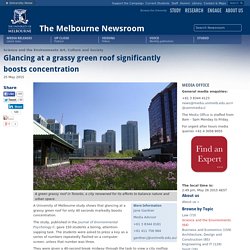
The students were asked to press a key as a series of numbers repeatedly flashed on a computer screen, unless that number was three. They were given a 40-second break midway through the task to view a city rooftop scene. Half the group viewed a flowering meadow green roof, the other half looked out onto a bare concrete roof. After the break, students who glanced at the greener vista made significantly less errors and demonstrated superior concentration on the second half of the task, compared to those who viewed the concrete roof.
The green roof provided a restorative experience that boosted those mental resources that control attention, researchers concluded. Lead researcher Dr Kate Lee, of the University of Melbourne Faculty of Science, said just a moment of green can provide a boost for tired workers. The 20 things that threaten Melbourne’s liveability. Many of Melbourne's future challenges are already ringing alarm bells today.
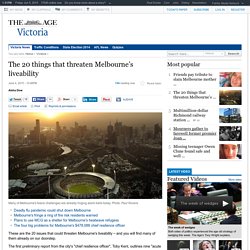
Photo: Paul Rovere These are the 20 issues that could threaten Melbourne's liveability – and you will find many of them already on our doorstep. The first preliminary report from the city's "chief resilience officer", Toby Kent, outlines nine "acute shocks" and 11 "chronic stresses" that could rock and weaken the city in the future. There are concerns Melbourne could one day be hit with an influenza pandemic or a widespread cyber attack.
The 15 Most Liveable Cities in The World and Why You Should Move There. What makes a city liveable for you? Things like transport, housing, political stability, health care, climate, crime rate and green areas are probably all on your list. These are more or less the same criteria used by the Economist Intelligence Unit (EIU) to come up with their list of the most liveable cities in the world.
It’s no surprise that the liveability rating has sunk for cities where unrest, war, or economic decline have dominated the headlines recently. Cities in this category include Damascus, Cairo, Tripoli, and Athens. The liveability index notes that cities with low population density in wealthier countries tend to get to the top of the list. So, according to the EIU and other sources, the top 15 most liveable cities (taking 30 factors into account) are:
Safe Cities Index 2015 White Paper. About the report he Safe Cities Index 2015 is an Economist Intelligence Unit report, sponsored by NEC. The report is based on an index composed of more than 40 quantitative and qualitative indicators. These indicators are split across four thematic categories: digital security; health security; infrastructure safety; and personal safety. Every city in the Index is scored across these four categories. Plan Melbourne - Plan Melbourne. More trees on your street means fewer health problems, says study. Residents report feeling better and having fewer health problems when there are more trees on their street, a new study has found. An online health survey of 31,109 residents living in the Canadian city of Toronto was combined with high-resolution satellite imagery and tree data.
The research was published in Scientific Reports on Thursday. Having on average 10 more trees in a city block improved how someone rated their health by a level comparable to an increase in annual personal income of $10,000, moving to a neighbourhood with $10,000 higher median income, or being seven years younger. A similar effect was found in reporting health problems such as hypertension, high blood glucose, obesity, with equivalent to a $20,200 income increase or being 1.4 years younger.
The paper’s lead author, Omid Kardan of the University of Chicago, said the experiment had been controlled for factors that could affect health, such as age, family income, education and diet. Email-a-Tree Service Doesn't Go As Planned in the Best Possible Way. Phase VI (2014-2018) of the WHO European Healthy Cities Network goals and requirements.
Health 2020: the European policy for health and well-being. Health 2020: the European policy for health and well-being Health 2020 is the new European health policy framework. It aims to support action across government and society to: “significantly improve the health and well-being of populations, reduce health inequalities, strengthen public health and ensure people-centred health systems that are universal, equitable, sustainable and of high quality”. Health Impact Assessment Community Knowledge Wiki / HEALTHY URBAN PLANNING GUIDANCE. City fact sheets: WHO European Healthy Cities Network. Australian Education City. Australian Education City. It's Werribee but not as you know it - high-tech city for 100,000 proposed. Grattan Institute. The cities we need. Texcoco Lake Ecological Park: Mexico City to Build the World's Largest Urban Park.
Echeverria hopes that the area of the central Mexico City valley once covered by Lake Texcoco can be reclaimed to create a new urban landscape that combines nature with infrastructure. 'Earthscraper' concept hides a 1,000-foot skyscraper underground. Global Liveability Ranking 2015. Explicit cookie consent. Architecture, Culture & Spirituality Forum. Home - Gehl Architects. Untitled. ABOVE THE FOLD. Green cities - Sustainable Melbourne. Human Effect: Public Installation. Catalyst: Future Cities - ABC TV Science. The Haven Project.